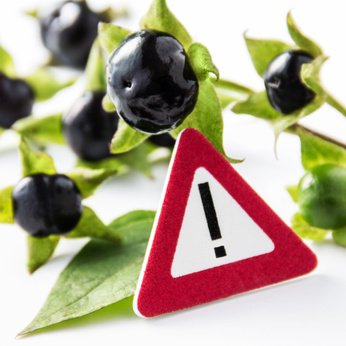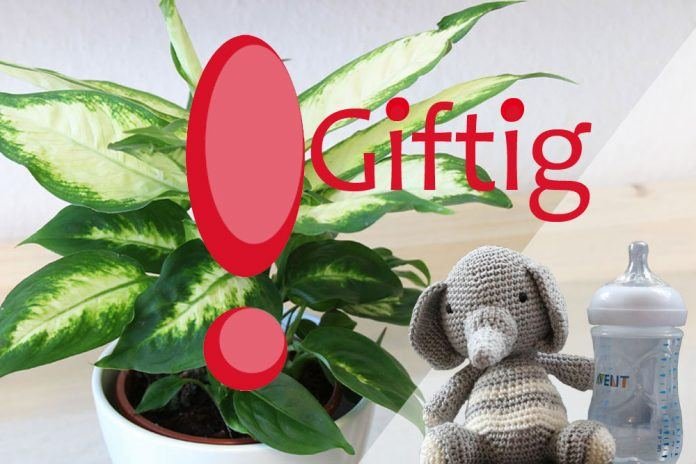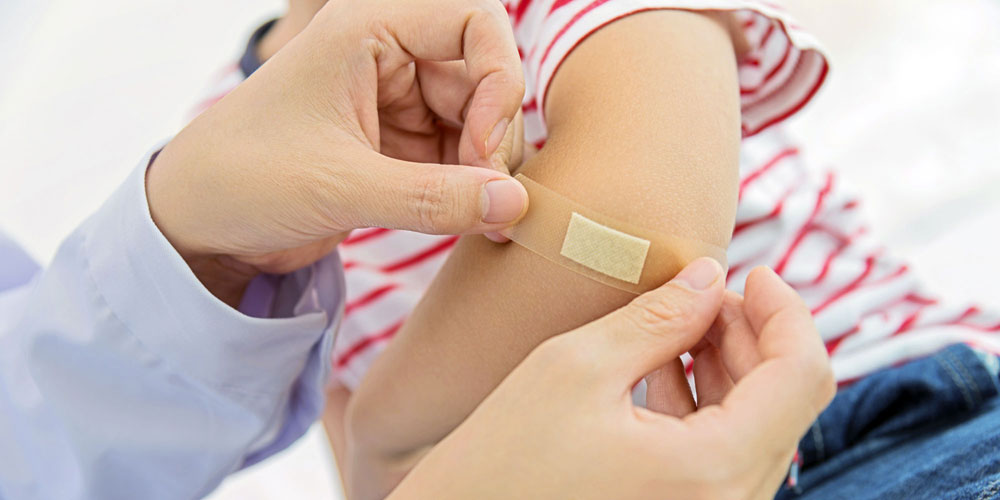Beautifully grown green plants and magnificent flowers that shimmer in all colors of the rainbow delight the eye and can immensely enhance the atmosphere in a room. But what is harmless decoration for us adults, is an enormous danger for babies and toddlers in some cases is.

Caution, toxic!
Infants not only touch everything that seems interesting to them, no, in most cases they will also put it in their mouths. The reason for this is quickly found: our offspring gain experience in the first months and years of their lives in this way, because they are simply not yet mentally able to question functions and listen to lengthy explanations.
Mothers and fathers have to take this aspect of your child’s development into account and should ensure the safety of the offspring by largely eliminating sources of danger such as poisonous houseplants. In order to do this, it is advantageous to be able to distinguish the toxic representatives of their type from harmless houseplants.
To help with this task, we have prepared a selection of some well-known plants that are toxic to humans:
- TOXIC
- VERY POISONUS
Hydrangea: The plant contains various substances that can cause dizziness and anxiety when consumed.
Window plant: Eating parts of this houseplant can cause the tongue to swell and difficulty swallowing.
Begonia: Not all types of begonia are toxic. Nevertheless, one should avoid buying the crop as long as small children live in the household. Poisoning manifests itself in severe diarrhea, vomiting and irritation of the mucous membranes.
Coral tree: All components of this plant are classified as toxic. The greatest threat to children, however, comes from the red fruits, which could be eaten quickly in an unobserved moment. Slight poisoning causes nausea and vomiting, and in worse cases, it can even lead to apnea.
primrose: All parts of this plant are poisonous. Even contact with the crop can trigger inflammation and irritation; if the plant is consumed, vomiting, diarrhea and stomach pain occur.
Cyclamen: The tuber and the leaves of the cyclamen are considered very toxic – however symptoms of poisoning usually only appear after the tuber has been consumed. The signs of poisoning are manifold and manifest themselves in nausea, stomach pain, diarrhea, vomiting, dizziness, sweating and even seizures.
Azalea: If parts of the plant are consumed, inflammation of the digestive tract, nausea and vomiting, fighting, diarrhea, sweating and disorders of the heart activity often occur.
Rubber tree / ficus: The milk juice in the leaves is slightly toxic. If swallowed, it causes severe abdominal pain and vomiting.
Christmas star: This plant is nice to look at, but should not get into a household with small children. Even putting small parts of plants in your mouth can irritate the mucous membranes in your mouth.
Knight’s star / amaryllis: The most toxic part is the flower bulb. But the rest of the flower (flowers and leaves) also contains substances that are slightly toxic and can cause skin irritation and nausea, among other things.
Daffodil: A pretty bouquet of daffodils on the table appeals to the eye of the beholder and unfortunately quickly fades away the danger that the plant poses. If parts of the flower are accidentally swallowed, the first symptoms will soon appear – such as nausea, vomiting, sweating and even diarrhea. In cases of severe poisoning, paralysis can even occur.
Blue and yellow monkshood: The monkshood is considered one of the most poisonous plants in Europe. The poison is most concentrated in the tuber, but the rest of the plant also has questionable amounts of toxic substances. Consuming the crop can also be fatal to adults. However, what makes the plant even more dangerous is the fact that the poison can even be absorbed into the body through the skin.
Foxglove: The strong poison of the crop is mainly found in the leaves. It triggers long-lasting nausea and vomiting. However, consuming the thimble can also be fatal.
Lily of the valley: All parts of the pretty flower are considered highly toxic. Even contact can irritate the skin. If parts of the crop are consumed, nausea, diarrhea, dizziness and irregular heartbeat occur. In the worst case, cardiac arrest can occur.
Holly / Christdorn: While the spiky leaves can cause minor injuries, the red berries are really dangerous. Their consumption leads to vomiting and diarrhea.
Dieffenbachia: Touching the plant triggers a reaction that can release strong toxins that hurt the skin and eyes.
Angel’s Trumpet: The leaves and seeds of this plant are considered highly toxic. In addition, the scent of the magnificent flower can trigger initial symptoms of poisoning, such as headache and nausea. If parts of the plant are consumed, it is essential to see a doctor.
This list may serve as a first orientation about which one generally known houseplants or plants that occur regularly in households are to be classified as toxic and not in households with small children belong. Yet it is not Completely, since it does not cover exotic plants or plants that children encounter in the wild.
First signs of poisoning
No child in this world is guarded and looked after by his parents around the clock. This would not only drive the child’s father and mother crazy, but would also have a negative impact on the development of the offspring. For this reason, it can be assumed that Children sometimes run through the apartment unsupervised and sometimes cannot resist the temptations of colorful houseplants.
It is particularly important for parents to recognize the first signs of poisoning, because the child is not always "caught in the act".
If the offspring vomit or complain about feeling unwell, this could be a first indication of poisoning. Sudden onset of inexplicable tiredness should also make parents take notice. Other possible signs of poisoning from houseplants are:
- Numbness in the extremities
- dizziness
- cramps
- respiratory disorders
- blurred vision
- skin irritation
- stomach pain
- hallucinations
A little older children will surely be able to tell the adults if they have put an unknown object in their mouth or even swallowed it. In this case, appropriate measures can be taken quickly.
If the offspring are not yet able to tell about possible incidents, the parents have to Monitor the course of symptoms and search the apartment for possible sources of danger or indications of what is happening (e.g. torn and gnawed leaves).
In an emergency: keep calm and act carefully
If the first suspicion is confirmed, the most important rule for an emergency is not to panic. Only a cool, clear-headed mind can make the right decisions in emergency situations. Accordingly, those affected should first take a deep breath, suppress the budding panic and fully devote themselves to the rescue measures.

Incidentally, this also means suppressing completely unimportant reactions. For example, a child who is at risk from swallowing poisonous parts of plants does not use it at all if the mother and father start with a harnessed timpani!
First it has to be clarified whether the toddler remains of the plant in the mouth Has. If this is the case, they must be spit out immediately.
Often worried parents who have noticed that part of the plant has been swallowed want their children to vomit to get the poisonous pieces out of the stomach. However, this is not recommended, since this measure does not have the desired effect with every type of poisoning. In the worst case, vomiting can even be counterproductive and exacerbate the emergency.
If poisoned by plants, it is therefore better to give the child plenty of still water to drink. The liquid will help with this, irritation of the gastrointestinal tract mitigate. Other drinks (such as milk) should not be used.
Then the houseplant from which it was eaten must be located to determine how toxic it is and to estimate the amount of plant material likely to have entered the body.
Once you have obtained this information, you can call one of the public Do not harm poison control centers in Germany. All previously known information about the incident must be passed on to the other party on the phone.
So the person on the other end of the line needs to know:
a) that the victim is a child (do not forget the age and weight)
b) which plant or which parts of the crop were consumed
c) what amount is likely to be in the stomach
d) what symptoms have already occurred
e) what period of time has elapsed since ingestion
The experts at the Poison Control Center are now able to provide the correct measures to the concerned parents treatment to explain the poisoning.
If there are serious symptoms that require medical intervention, the emergency call should be made directly and an emergency doctor or ambulance should be requested!
Avoid all flowers and ornamental plants?
In conclusion, of course not all plants as a potential source of danger are to be seen. If you like to decorate your room with colorful flowers, you can continue to do so. It is only important to use harmless specimens.
For example, roses are among those flowers in which there are no harmful substances that could lead to poisoning if they are accidentally consumed. If the bouquet of roses is placed within the reach of small children, all thorns should be cut off beforehand to avoid any risk of injury.
Additional, colorful splashes of color and fresh accents are provided by, among other things, harmless houseplants such as palm trees, camellias, geraniums, pansies, African violets, blue lieschen, hard-working lieschen, hibiscus, dahlia or slipper flower – this is already a colorful selection of beautiful flowers and green plants can be safely placed in the room, when babies and toddlers romp around the rooms.
Nevertheless, it is advisable to teach the youngsters as early as possible to stay away from unknown plants and not to put them in your mouth! In your own household, you can make sure that the children’s environment is as safe as possible – but at the latest on forays into the great outdoors, the offspring will encounter poisonous plants such as the yew tree that lures with its red berries.
Therefore, it makes sense to teach the youngest right from the start to rather keep their hands off unknown plants.
RELATED ITEMS
-

Caution: poisonous plants from the garden – baby and family
Some plants from the garden or balcony can cause poisoning. Poisonous plants that children should stay away from…
-

Checklist with 20 indoor plants: poisonous plants for children and babies
Plants are not only useful, but also an appealing ornament and are part of your well-being. However, caution is advised, as not all…
-

Which houseplants are poisonous? Baby and family
They are not only beautiful, but sometimes also poisonous or prickly: houseplants. What parents should consider when choosing to have their child…
-

Online games – chance or danger for children and teenagers?
Children and adolescents and their media consumption are repeatedly criticized. Normally, children now have a computer, a television,…
